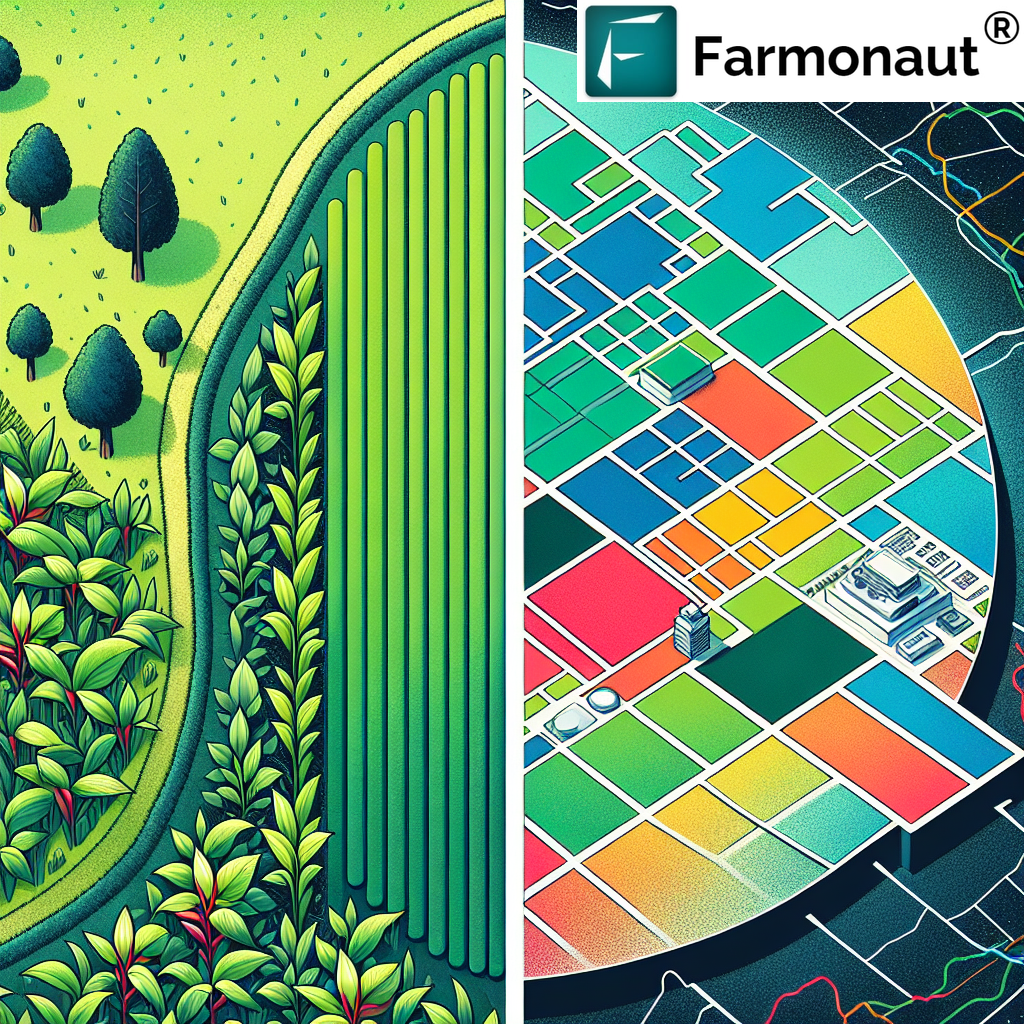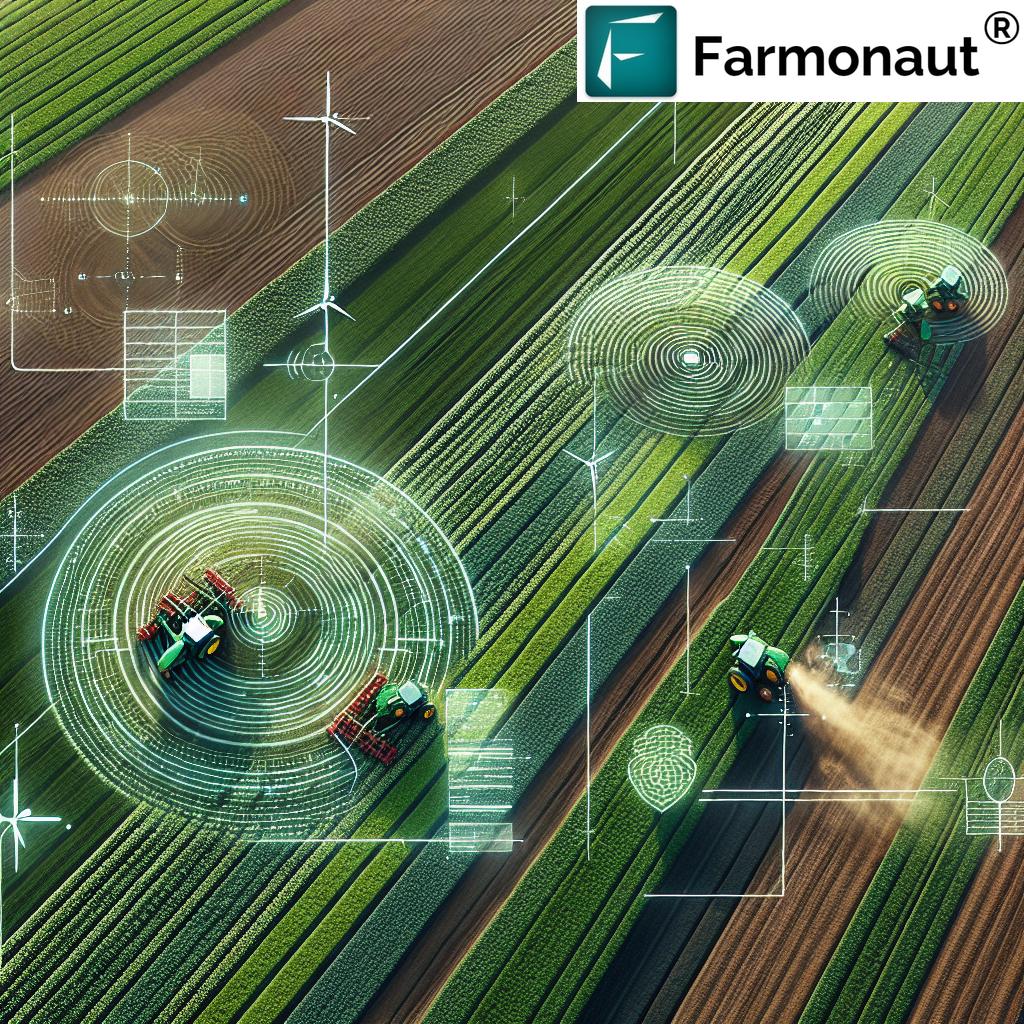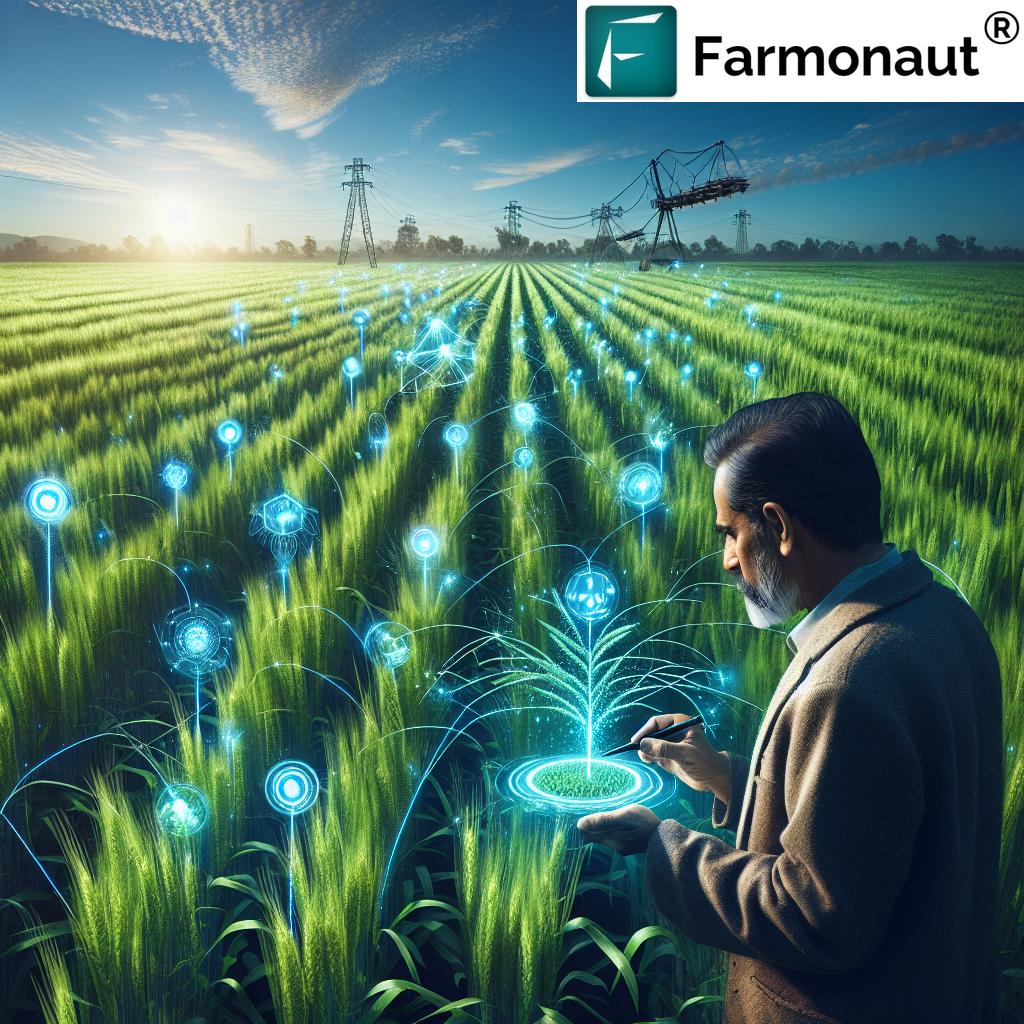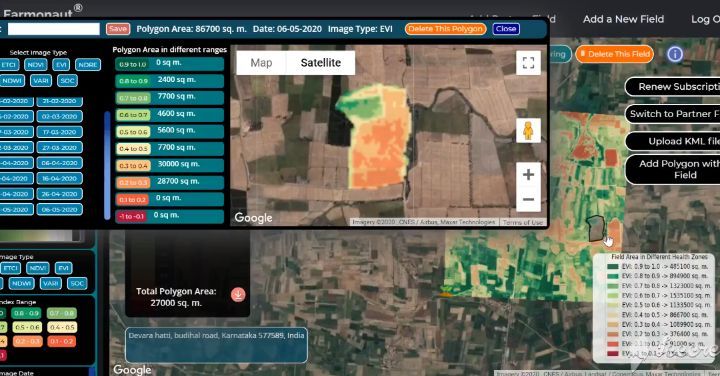
Maximizing Crop Yields: A Comprehensive Guide to Modern Farming Techniques
In the ever-evolving world of agriculture, staying ahead of the curve is crucial for farmers and agribusinesses alike. At Farmonaut, we understand the challenges faced by the agricultural community and are committed to providing innovative solutions that revolutionize farming practices. In this comprehensive blog post, we’ll delve into various aspects of modern farming, from soil classification to crop-specific growth strategies, and explore how technology is reshaping the agricultural landscape.
Table of Contents
- Understanding Bhumi Ka Vargikaran (Soil Classification)
- Bhumi Ki Shreni: Soil Types and Their Characteristics
- The Growth Monitoring Drive in Telangana
- Mastering the Growth Stages of Potatoes
- Kapas Ki Growth Kaise Badhaye: Enhancing Cotton Yield
- Patson Ki Kheti: Cultivating Success in Pea Farming
- Farmonaut’s Cutting-Edge Solutions for Modern Agriculture
- FAQ Section
1. Understanding Bhumi Ka Vargikaran (Soil Classification)
Bhumi ka vargikaran, or soil classification, is a fundamental concept in agriculture that plays a crucial role in determining crop suitability and management practices. At Farmonaut, we recognize the importance of understanding soil types to maximize agricultural productivity.
The Importance of Soil Classification
- Guides crop selection
- Determines appropriate fertilization strategies
- Informs irrigation practices
- Helps in predicting soil behavior
Soil classification systems vary across the world, but they all aim to categorize soils based on their physical, chemical, and biological properties. In India, the National Bureau of Soil Survey and Land Use Planning (NBSS&LUP) has developed a comprehensive system that classifies soils into various orders, suborders, and groups.
Major Soil Orders in India
- Inceptisols: Young soils with minimal horizon development
- Entisols: Recently formed soils with little or no profile development
- Vertisols: Clay-rich soils that shrink and swell with changes in moisture
- Alfisols: Moderately leached soils with a clay-enriched subsoil
- Ultisols: Highly weathered, acidic soils common in tropical and subtropical regions
Understanding bhumi ka vargikaran is essential for implementing precision agriculture techniques. At Farmonaut, our satellite-based crop health monitoring system takes into account soil characteristics to provide more accurate and tailored recommendations for farmers.
2. Bhumi Ki Shreni: Soil Types and Their Characteristics
Bhumi ki shreni refers to the various soil types found across different regions. Each soil type has unique properties that influence crop growth and management practices. Let’s explore some of the major soil types in India and their characteristics:
Alluvial Soil
- Formed by river deposits
- Highly fertile and rich in minerals
- Ideal for crops like rice, wheat, and sugarcane
- Found in the Indo-Gangetic plains and coastal areas
Black Cotton Soil (Regur)
- Rich in clay content
- High water-retention capacity
- Suitable for cotton, sorghum, and pulses
- Prevalent in the Deccan Plateau region
Red and Yellow Soil
- Derived from crystalline and metamorphic rocks
- Rich in iron oxides
- Suitable for millets, groundnuts, and pulses
- Found in parts of Tamil Nadu, Karnataka, and Madhya Pradesh
Laterite Soil
- Highly weathered and leached
- Rich in iron and aluminum oxides
- Suitable for tea, coffee, and rubber plantations
- Common in high rainfall areas of Kerala, Karnataka, and Assam
Desert Soil
- Sandy texture with low organic content
- Poor water retention capacity
- Suitable for drought-resistant crops
- Found in arid regions of Rajasthan and parts of Gujarat
At Farmonaut, we integrate soil type information into our AI-driven advisory system, Jeevn AI, to provide farmers with tailored recommendations based on their specific bhumi ki shreni. This approach ensures that our users receive advice that’s not only crop-specific but also soil-specific, leading to optimized resource use and improved yields.
3. The Growth Monitoring Drive in Telangana
The growth monitoring drive in Telangana is an exemplary initiative that showcases the power of technology in modern agriculture. This program, implemented by the Telangana government in collaboration with various agricultural institutions and tech companies, aims to revolutionize crop monitoring and management across the state.
Key Aspects of the Growth Monitoring Drive
- Satellite-based crop monitoring
- Real-time data collection and analysis
- AI-driven yield prediction
- Pest and disease forecasting
- Precision agriculture recommendations
At Farmonaut, we’re proud to be at the forefront of similar initiatives, offering our advanced satellite-based farm management solutions to farmers and governments worldwide. Our technology aligns perfectly with the goals of programs like the Telangana growth monitoring drive, enabling large-scale, data-driven agricultural management.
Benefits of Satellite-Based Growth Monitoring
- Wide Coverage: Satellites can monitor vast agricultural areas efficiently.
- Frequent Updates: Regular imagery allows for timely interventions.
- Non-Invasive: Monitoring doesn’t disturb crops or soil.
- Cost-Effective: More economical than ground-based surveys for large areas.
- Data Integration: Satellite data can be easily combined with other datasets for comprehensive analysis.
The success of the growth monitoring drive in Telangana serves as a testament to the potential of satellite technology in agriculture. At Farmonaut, we’re committed to bringing these benefits to farmers and agricultural stakeholders globally through our innovative platform.
4. Mastering the Growth Stages of Potatoes
Understanding the growth stages of potatoes is crucial for maximizing yield and quality. As a staple crop in many parts of the world, potatoes require careful management throughout their growth cycle. Let’s explore the key stages and how Farmonaut’s technology can assist in optimizing potato cultivation.
Potato Growth Stages
- Sprout Development:
- Duration: 2-4 weeks
- Sprouts emerge from seed potatoes
- Critical for establishing plant population
- Vegetative Growth:
- Duration: 3-5 weeks
- Rapid leaf and stem development
- Important for photosynthesis and nutrient uptake
- Tuber Initiation:
- Duration: 2-3 weeks
- Stolons begin to swell and form tubers
- Crucial for determining potential yield
- Tuber Bulking:
- Duration: 6-8 weeks
- Rapid tuber growth and expansion
- Highest water and nutrient demand
- Maturation:
- Duration: 2-3 weeks
- Vines begin to yellow and die
- Tuber skin sets and hardens
At Farmonaut, our satellite-based crop monitoring system can track the progress of potato crops through these growth stages, providing valuable insights to farmers. Our technology enables:
- Early detection of stress factors affecting growth
- Optimization of irrigation scheduling based on crop needs
- Timely application of fertilizers and pest control measures
- Accurate prediction of harvest dates
By leveraging our advanced monitoring capabilities, potato farmers can make informed decisions at each growth stage, leading to improved yields and better crop quality.
5. Kapas Ki Growth Kaise Badhaye: Enhancing Cotton Yield
Kapas ki growth kaise badhaye (How to enhance cotton growth) is a question that many cotton farmers grapple with. Cotton is a crucial cash crop, and maximizing its yield requires a comprehensive understanding of its growth requirements and the application of modern agricultural techniques.
Key Strategies for Enhancing Cotton Growth
- Proper Seed Selection:
- Choose high-yielding, disease-resistant varieties
- Consider Bt cotton for pest resistance
- Optimal Planting Practices:
- Follow recommended planting dates for your region
- Maintain appropriate plant spacing
- Soil Management:
- Conduct regular soil tests
- Apply balanced fertilizers based on soil needs
- Water Management:
- Implement efficient irrigation systems
- Monitor soil moisture levels regularly
- Pest and Disease Control:
- Practice integrated pest management (IPM)
- Monitor crops regularly for early detection of issues
- Timely Harvesting:
- Harvest when 60-70% of bolls are open
- Avoid harvesting during wet conditions
At Farmonaut, we understand the complexities of cotton cultivation and offer tailored solutions to help farmers enhance their kapas ki growth. Our satellite-based monitoring system provides:
- Real-time crop health assessment
- Early detection of stress factors
- Precise irrigation recommendations
- Timely alerts for pest and disease outbreaks
By integrating our technology into their cotton management practices, farmers can make data-driven decisions that lead to improved yields and quality. Our Jeevn AI advisory system further enhances this by providing personalized recommendations based on real-time crop conditions and historical data.
6. Patson Ki Kheti: Cultivating Success in Pea Farming
Patson ki kheti, or pea cultivation, is an important agricultural practice in many regions of India. Peas are not only a nutritious vegetable but also a valuable crop for soil improvement due to their nitrogen-fixing properties. Let’s explore the key aspects of successful pea farming and how Farmonaut’s technology can optimize the process.
Essential Factors for Successful Pea Cultivation
- Climate Requirements:
- Cool temperatures (15-20°C) during growth
- Moderate rainfall or irrigation
- Soil Preparation:
- Well-drained, fertile soil with pH 6.0-7.5
- Thorough plowing and leveling
- Sowing Techniques:
- Proper seed spacing (30-45 cm between rows)
- Optimal sowing depth (3-5 cm)
- Nutrient Management:
- Balanced NPK application
- Foliar sprays for micronutrients
- Water Management:
- Regular, light irrigations
- Critical irrigation during flowering and pod formation
- Pest and Disease Control:
- Monitoring for common pests like aphids and pod borers
- Preventive measures against diseases like powdery mildew
- Harvesting:
- Timely harvesting when pods are fully developed but still green
- Multiple harvests for maximum yield
At Farmonaut, we’re committed to enhancing patson ki kheti through our advanced agricultural technologies. Our satellite-based monitoring system offers several benefits for pea farmers:
- Precise crop health monitoring throughout the growing season
- Early detection of stress factors affecting pea plants
- Optimization of irrigation scheduling based on crop needs and weather forecasts
- Timely alerts for potential pest and disease outbreaks
- Yield prediction to help plan harvesting and marketing strategies
By leveraging our technology, pea farmers can make informed decisions that lead to improved yields, better crop quality, and more sustainable farming practices.
7. Farmonaut’s Cutting-Edge Solutions for Modern Agriculture
At Farmonaut, we’re revolutionizing agriculture through our advanced, satellite-based farm management solutions. Our mission is to make precision agriculture accessible and affordable for farmers worldwide, integrating innovative technology with traditional farming practices.
Key Technologies and Services
- Satellite-Based Crop Health Monitoring: Real-time insights into vegetation health, soil moisture, and critical metrics.
- Jeevn AI Advisory System: Personalized farm advice powered by artificial intelligence.
- Blockchain-Based Product Traceability: Ensuring transparency and security in agricultural supply chains.
- Fleet and Resource Management: Optimizing agricultural operations and logistics.
- Carbon Footprinting: Helping agribusinesses monitor and reduce their environmental impact.
How Farmonaut Compares to Other Farm Monitoring Systems
| Feature | Farmonaut Satellite System | Drone-based Monitoring | IoT-based Monitoring |
|---|---|---|---|
| Coverage Area | Large scale (Global) | Limited (Local) | Limited (Sensor placement) |
| Data Frequency | Regular (1-5 days) | On-demand | Continuous |
| Initial Setup Cost | Low | High | Medium to High |
| Operational Complexity | Low | High | Medium |
| Weather Dependency | Moderate | High | Low |
| Data Integration | Easy | Moderate | Moderate |
| Scalability | High | Low | Medium |
Our comprehensive suite of tools addresses diverse agricultural needs, from precision farming to supply chain transparency and sustainability. By lowering the cost barrier and providing advanced solutions, we’re empowering farmers, improving productivity, and promoting sustainable agricultural practices globally.
To experience the power of Farmonaut’s technology, visit our app page or explore our API services. Download our mobile app for Android or iOS to start optimizing your farming practices today.
For developers interested in integrating our powerful tools into their own applications, check out our API documentation.
8. FAQ Section
Q1: What is bhumi ka vargikaran and why is it important?
A1: Bhumi ka vargikaran refers to soil classification. It’s important because it helps determine crop suitability, guides fertilization strategies, and informs irrigation practices, ultimately leading to better farm management and higher yields.
Q2: How does Farmonaut’s technology help in kapas ki growth (cotton growth)?
A2: Farmonaut’s satellite-based monitoring system provides real-time crop health assessment, early stress detection, precise irrigation recommendations, and timely pest and disease alerts, all of which contribute to enhancing cotton growth and yield.
Q3: What are the key stages in potato growth?
A3: The main stages of potato growth are sprout development, vegetative growth, tuber initiation, tuber bulking, and maturation. Each stage has specific requirements that Farmonaut’s technology can help monitor and optimize.
Q4: How can farmers benefit from the growth monitoring drive in Telangana?
A4: The growth monitoring drive in Telangana uses satellite technology for real-time crop monitoring, yield prediction, and pest forecasting. Farmers benefit from timely interventions, better resource management, and improved decision-making based on data-driven insights.
Q5: What are some tips for successful patson ki kheti (pea cultivation)?
A5: Key factors for successful pea cultivation include proper soil preparation, appropriate sowing techniques, balanced nutrient management, efficient water management, and timely pest and disease control. Farmonaut’s technology can assist in monitoring and optimizing these factors.
Q6: How does Farmonaut’s satellite monitoring compare to drone-based systems?
A6: Farmonaut’s satellite monitoring offers wider coverage, lower setup costs, and easier scalability compared to drone-based systems. While drones provide high-resolution imagery, satellites offer more frequent and consistent data collection over large areas.
Q7: Can Farmonaut’s technology be used for all types of crops?
A7: Yes, Farmonaut’s satellite-based monitoring and AI advisory systems are designed to work with a wide range of crops, including staple grains, cash crops, fruits, and vegetables.
Q8: How does bhumi ki shreni (soil type) affect farming practices?
A8: Different soil types (bhumi ki shreni) have varying water retention capacities, nutrient content, and physical properties. Understanding your soil type helps in choosing appropriate crops, determining fertilizer needs, and planning irrigation strategies.
Q9: Is Farmonaut’s technology suitable for small-scale farmers?
A9: Absolutely. Farmonaut’s solutions are designed to be accessible and affordable for farmers of all scales, from small-scale operations to large agribusinesses.
Q10: How can I get started with Farmonaut’s services?
A10: You can start by downloading our mobile app from the Google Play Store or the Apple App Store. For more information or to explore our web-based services, visit our website.
In conclusion, modern agriculture is a complex field that requires a deep understanding of various factors, from soil classification to crop-specific growth strategies. At Farmonaut, we’re committed to providing farmers with the tools and insights they need to navigate these complexities and achieve optimal yields. By leveraging our advanced satellite-based technologies and AI-driven advisory systems, farmers can make informed decisions, optimize resource use, and contribute to a more sustainable and productive agricultural future.














